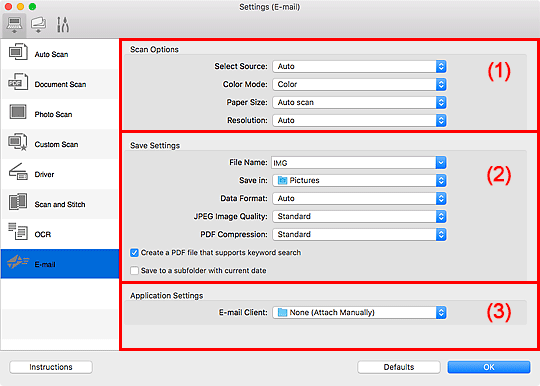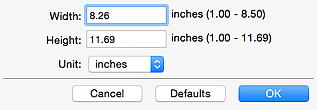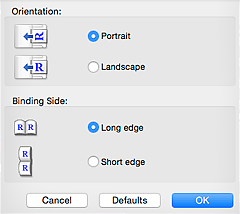IJ Scan Utility Lite - Settings (E-mail) Dialog
| Article ID: ART171173 | | | Date published: 07/30/2018 | | | Date last updated: 09/02/2021 |
Description
Learn about the options that can be adjusted in the Settings (E-mail) dialog in IJ Scan Utility Lite for macOS.
Solution
Click E-mail on the  (Scanning from a Computer) tab to display the Settings (E-mail) dialog.
(Scanning from a Computer) tab to display the Settings (E-mail) dialog.
In the Settings (E-mail) dialog, make advanced settings for attaching scanned images to an e-mail.

 The displayed items and available settings vary depending on your scanner or printer.
The displayed items and available settings vary depending on your scanner or printer.
(1) Scan Options Area
-
Select Source
-
Select the type of item to be scanned. Select Auto to detect the item type automatically and to set Color Mode, Paper Size, and Resolution automatically as well.
 When scanning documents from ADF (Auto Document Feeder) with Auto selected, Paper Size will not be set automatically.
When scanning documents from ADF (Auto Document Feeder) with Auto selected, Paper Size will not be set automatically. Item types supported by Auto are photos, postcards, business cards, magazines, newspapers, documents, and BD/DVD/CD.
Item types supported by Auto are photos, postcards, business cards, magazines, newspapers, documents, and BD/DVD/CD. To scan the following types of items, specify the item type or size. You cannot scan correctly with Auto.
To scan the following types of items, specify the item type or size. You cannot scan correctly with Auto.-
A4 size photos
-
Text documents smaller than 2L (5 inches x 7 inches) (127 mm x 178 mm), such as paperback pages with the spine cut off
-
Items printed on thin white paper
-
Long narrow items such as panoramic photos
 Reflective disc labels may not be scanned as expected.
Reflective disc labels may not be scanned as expected. Place items correctly according to the type of item to be scanned. Otherwise, items may not be scanned correctly.
Place items correctly according to the type of item to be scanned. Otherwise, items may not be scanned correctly. When scanning two or more documents from the ADF, place documents of the same size even if Auto is set.
When scanning two or more documents from the ADF, place documents of the same size even if Auto is set. In Auto Scan, the outline of the subjects is emphasized.
In Auto Scan, the outline of the subjects is emphasized. To convert text in the image into text data after scanning, specify Select Source instead of selecting Auto.
To convert text in the image into text data after scanning, specify Select Source instead of selecting Auto. To reduce moire, set Select Source to Magazine or select the Reduce moire checkbox in Image Processing Settings.
To reduce moire, set Select Source to Magazine or select the Reduce moire checkbox in Image Processing Settings. -
-
Color Mode
-
Select the color mode in which to scan the item.
 Only Color is available when Select Source is Auto.
Only Color is available when Select Source is Auto. -
Paper Size
-
Select the size of the item to be scanned.
When you select Custom, a screen in which you can specify the paper size appears. Select a Unit, then enter the Width and Height, and then click OK.

 Only Auto scan is available when Select Source is Auto.
Only Auto scan is available when Select Source is Auto. Click Defaults in the screen in which you can specify the paper size to restore the specified settings to the default settings.
Click Defaults in the screen in which you can specify the paper size to restore the specified settings to the default settings. -
ADF Paper Size
-
This appears when using the ADF and Select Source is Auto. Select the size of the document to be scanned from the ADF.
-
Resolution
-
Select the resolution of the item to be scanned.
The higher the resolution (value), the more detail in your image.
 Only Auto is available when Select Source is Auto.
Only Auto is available when Select Source is Auto. -
Document Scan Orientation Settings...
-
This appears when you select Auto, Document, or ADF for Select Source.
Click to display the Document Scan Orientation Settings dialog in which you can set the orientation and binding side of the documents to be scanned from the ADF.

 Binding Side cannot be specified when scanning only the front side of each document.
Binding Side cannot be specified when scanning only the front side of each document. -
Image Processing Settings
-
Click
 (Right Arrow) to set the following. Available settings vary depending on the Select Source setting.
(Right Arrow) to set the following. Available settings vary depending on the Select Source setting.-
When Select Source is Photo:
 When Color Mode is Black and White, Image Processing Settings is not available.
When Color Mode is Black and White, Image Processing Settings is not available.-
Sharpen outline
-
Emphasizes the outline of the subjects to sharpen the image.
-
-
When Select Source is Magazine or Document:
 The displayed items vary depending on Color Mode.
The displayed items vary depending on Color Mode.-
Sharpen outline
-
Emphasizes the outline of the subjects to sharpen the image.
-
Reduce show-through
-
Sharpens text in an item or reduces show-through in newspapers, etc.
-
Reduce moire
-
Reduces moire patterns.
Printed materials are displayed as a collection of fine dots. "Moire" is a phenomenon where uneven gradation or a stripe pattern appears when such photos or pictures printed with fine dots are scanned.
 Scanning takes longer than usual when you enable Reduce moire.
Scanning takes longer than usual when you enable Reduce moire. -
Correct slanted text document
-
Detects the scanned text and corrects the angle (within -0.1 to -10 degrees or +0.1 to +10 degrees) of the document.
 The following types of documents may not be corrected properly since the text cannot be detected correctly.
The following types of documents may not be corrected properly since the text cannot be detected correctly.-
Documents in which the text lines are inclined more than 10 degrees or the angles vary by line
-
Documents containing both vertical and horizontal text
-
Documents with extremely large or small fonts
-
Documents with small amount of text
-
Documents containing figures/images
-
Hand-written text
-
Documents containing both vertical and horizontal lines (tables)
 Scanning takes longer than usual when you enable Correct slanted text document.
Scanning takes longer than usual when you enable Correct slanted text document. -
-
Detect the orientation of text document and rotate image
-
Automatically rotates the image to the correct orientation by detecting the orientation of text in the scanned document.
 The orientation may not be detected for the following types of settings or documents since the text cannot be detected correctly.
The orientation may not be detected for the following types of settings or documents since the text cannot be detected correctly.-
Resolution is outside the range of 300 dpi to 600 dpi
-
Font size is outside the range of 8 points to 48 points
-
Documents containing special fonts, effects, italics, or hand-written text
-
Documents with patterned backgrounds
-
-
-
In that case, select the Check scan results and specify save settings checkbox, and then rotate the image in the Save Settings dialog.
(2) Save Settings Area
-
File Name
-
Enter the file name of the image to be saved. When you save a file, the date and four digits are appended to the set file name in the "_20XX0101_0001" format.
 When you select the Save to a subfolder with current date checkbox, the date and four digits are appended to the set file name.
When you select the Save to a subfolder with current date checkbox, the date and four digits are appended to the set file name. -
Save in
-
Displays the folder in which to save the scanned images. To add a folder, select Add... from the pop-up menu, then click
 (Plus) in the displayed dialog and specify the destination folder.
(Plus) in the displayed dialog and specify the destination folder.The default save folder is the Pictures folder.
-
Data Format
-
Select the data format in which to save the scanned images.
You can select JPEG/Exif, TIFF, PNG, PDF, PDF (Multiple Pages), or Auto.
 When Auto is selected, the save format may differ depending on how you place the item.
When Auto is selected, the save format may differ depending on how you place the item. You cannot select JPEG/Exif when Color Mode is Black and White.
You cannot select JPEG/Exif when Color Mode is Black and White. Auto appears only when Auto is selected for Select Source.
Auto appears only when Auto is selected for Select Source. With network connection, scanning may take longer than usual when you set TIFF or PNG in Data Format.
With network connection, scanning may take longer than usual when you set TIFF or PNG in Data Format. -
JPEG Image Quality
-
You can specify the image quality of JPEG files.
 This appears only when JPEG/Exif or Auto is selected in Data Format.
This appears only when JPEG/Exif or Auto is selected in Data Format. -
PDF Compression
-
Select the compression type for saving PDF files.
-
Standard
-
It is recommended that you normally select this setting.
-
High
-
Compresses the file size when saving, allowing you to reduce the load on your network/server.
 This appears only when PDF, PDF (Multiple Pages), or Auto is selected in Data Format.
This appears only when PDF, PDF (Multiple Pages), or Auto is selected in Data Format. When Black and White is selected in Color Mode, this option does not appear.
When Black and White is selected in Color Mode, this option does not appear. -
-
Create a PDF file that supports keyword search
-
Select this checkbox to convert text in images into text data and create PDF files that support keyword search.
 This appears only when PDF, PDF (Multiple Pages), or Auto is selected in Data Format.
This appears only when PDF, PDF (Multiple Pages), or Auto is selected in Data Format. -
Save to a subfolder with current date
-
Select this checkbox to create a current date folder in the folder specified in Save in and save scanned images in it. The folder will be created with a name such as "20XX_01_01" (Year_Month_Date).
If this checkbox is not selected, files are saved directly in the folder specified in Save in.
-
Check scan results and specify save settings
-
Displays the Save Settings dialog after scanning.
 This does not appear when Select Source is Auto.
This does not appear when Select Source is Auto.
(3) Application Settings Area
-
E-mail Client
-
Specify the e-mail client to use for attaching scanned images.
 To add an e-mail client to the pop-up menu, select Add... from the pop-up menu, then click
To add an e-mail client to the pop-up menu, select Add... from the pop-up menu, then click  (Plus) in the displayed dialog and specify the e-mail client.
(Plus) in the displayed dialog and specify the e-mail client.
-
Instructions
-
Opens this guide.
-
Defaults
-
You can restore the settings in the displayed screen to the default settings.
